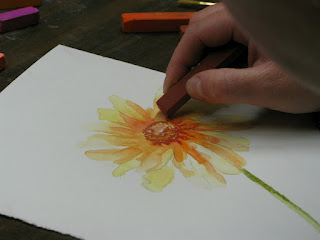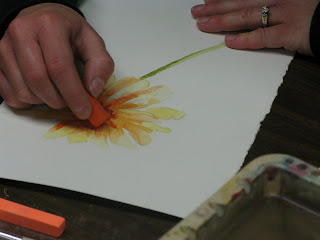This is the
theory behind the blind contour exercises; it has to do with how our brains
work,
I will be
quoting from Betty Edwards: “Drawing on the Artist Within” beginning at page 10
“The two
major modes of human brain-hemisphere function (which I can simply L-mode an
R-Mode) were first described by psycho-biologist Roger W Sperry in his
pioneering work during the late 1950’s and early 1960’s Sperry’s research,
which was honored by a Nobel Prize for Medicine in 1981, has shown that the
right and left hemispheres of the human brain use contrasting method of
information processing. Both thinking modes
are involved in high-level information processing. Both thinking modes are involved in
high-level cognitive functioning, but each brain half specializes in its own
style of thinking and each has its own special capabilities. The two modes are able to work in
cooperative, complementary way while at the same time retaining their
individual styles of thinking.
Nevertheless,
these styles of thinking are fundamentally
different and can cause each mode, in a sense, to view reality in its own
way. Thus, in response to an even “out
there, “one brain half or the other may “jump in” first to dominate conscious
awareness—or, in other instances, the two modes may have different and even conflicting
responses to the same event. In some
situation’s one response or the other may be somehow suppressed and kept out of
conscious awareness. A child for example,
whose angry mothers says through clenched teeth, “I’m disciplining you because
I love you,’ may, as a subconscious protective device, choose to believe the
words and deny (at a conscious level) seeing the anger. On the other hand, conflicting responses to
an even may both reach conscious awareness and both views may be expressed in
words For example, someone who has just
viewed a televised political speech might say, “The words sound okay, but there’s
something about this person that I just don’t like.”
The left
hemisphere (for the majority of human beings) specializes in verbal, logical
and analytic thinking. Naming and
categorizing are among its favorite things to go. It excels in symbolic abstraction,
speech, reading, writing, arithmetic. In general, its system of thought is
linear: first things first, second things second. It tends to rely on general rules to reduce
experience to concepts that are compatible with its style of cognition (thinking). Its preference is for clear, sequential,
logical thought, uncomplicated by paradox or ambiguity. Perhaps because of its bewildering
complexity, our culture generally tends to emphasize L-mode thinking, thus
funneling complexity down into manageable words, symbols or abstractions and
enabling us to cope, more or less with many aspects of modern living……
A good
example from everyday life of a task appropriate for L-mode’s style of thinking
is balancing your checkbook. Using words
and numbers and following a prescribed procedure, checkbook balancing is a
language –based, sequential, linear process.
At the start,
the assumption is made that if you have kept all the records straight, you can
expect to end with a valance of $0.00. If
in face you end up with a balance of say $1.06, R-mode (which is not interested
in this process) may nudge you with the (unspoken) impulse “let's just erase
that and write in $0.00. It doesn’t really matter.” L-mode, however would feel
that it does matter and would respond indignantly, “No, no no! I must go back
to the beginning and go through the procedure step by step until I find the
error.” L- mode, of course, is the
appropriate mode for balancing a check book, as its style of cognition is
suited to the task. R-mode is simply not
equipped for this L-mode job, and surely the last thing wanted is creative
checkbook balancing.
In contrast
to L-mode, the right half of the brain (for most individuals) functions in a
nonverbal manner specializing in visual, special perceptional information. Its style of processing is nonlinear and
nonsequential relying instead on simultaneous processing of incoming
information- looking at the whole thing at once. It tends to see relationships between parts
and searches for the ways parts fit together to form wholes. It s preference is for perceiving information
, searching for patterns or relationships that satisfy requirements for visual
fit and seeking special order and coherence.
It seems undaunted by ambiguity, complexity or paradox, perhaps because
it lacks the ‘reducing glass” of L-mode, which opts for general rules and
resists acknowledging ambiguity and paradox.
Because of its quickness, complexity and nonverbal nature, R-mode
thinking is almost by definition, difficult to put into words.
A good
example of this is driving on the freeway.
TO PARAPHRASE: For the L-mode to
change lanes it would need to make mathematical calculation with speed of
various cars consider per second ratios
Whereas the R-mode, which is intuitively spatially oriented is more
suited for the job of changing lanes.
The two
brains do work together and are actually connected by the corpus callosum and
form one identity.
Yet a duality
seems to exist. Some inner knowledge of
this duality of the brain seems to be harbored deep in human consciousness,
surfacing like an iceberg’s tip, in language itself. For Example philosophers through the ages
have proposed of two ways of knowing the external world, through the intellect
and through the emotions: through logical analysis and metaphorical
synthesis. Dichotomous terms (terms in
twos) abound: yin and yang, rational and poetic, abstract and concrete,
scientific and imaginative. Individuals
often speak of themselves as if two separate personalities existed in tandem:
“Part of me wants to do such and such, but on the other hand I know I’m better off
doing so and so.” Or “Sometimes I’m really rational and on time, and
dependable, but at other times I’m just off the wall.”
I am
left-handed so that means I have a more dominant right brain, than most. In most
humans the L-brain has dominance over the R-brain, though both sides of the
brain are used.
The creative
process and in particular drawing is a special and primarily a non-linear
process. The creative process requires
the ability to tap into the R-brain at will.
In other words the artist must learn to control the mental shifts at
will in order to tap into the strengths of the R-brain.
Again I will explain how to proceed with blind contour.
Now I will
explain in specific what is surmised to be going on in your brain when you
begin doing blind contour drawing. For
starters you remember I said you must work Slooooooowly, never look at your
hand or paper….only look in minute detail of what you are attempting to
draw. Now I am going to give you a time frame.
Ten minutes, don’t look at the timer or stop. (you probably don’t have a
timer…oh well). (Sic .p146f) Ignore the protests from the L-mode, that
this is “too slow, too boring, too ridiculous, and too useless for words.” Just
keep on drawing, and soon the L-Mode will fade away-to take a little time
off. At that point you may find yourself
seeing differently. You may find yourself wanting to see more and
then even more. The information, the
complex patterns of tiny edges and lines, may begin to seem strangely intensely
interesting. Allow this to happen: this is the shift in vision that I am
looking for.
As you feel
yourself entering a somewhat different mood, or state of consciousness, do not
resist it. The R-mode is pleasurable and
satisfying; one feels alert interested, self-confident, and concentrated on the
task at hand. Nevertheless some
individuals find this mental shift fearful and alarming. It need not be feared, because the state is
so ephemeral, so fragile that the slightest interruption can break the spell or
you yourself can easily break the spell if you wish.
What is the
fear? A speculation, partly in jest:
L-Mode may fear if you get ‘over there” deeply enough you may not want to “come
back.” More seriously, if the fear is one of “losing control” there is nothing
to worry about... When the timer sounds,
you will be back all too completely to your “normal” L-mode state As every creative person knows, the real problem is to sustain the elusive
r-mode state long enough to finish the job at hand.
Now begin to draw.
I hope you can think about and practice your
drawing.
If you would like to learn more about classes from Judith Reidy click here.
 Also instructors Lorin Willey and Judith Reidy are announcing their fall classes at the Clinton. You may select any number of great classes on the classes page
Also instructors Lorin Willey and Judith Reidy are announcing their fall classes at the Clinton. You may select any number of great classes on the classes page 





















